A reproduction of an article by Lim Kim Seng, originally published in Singapore Avifauna Volume 22 No 7, July 2008.
Notes on the Identification, Status and Distribution of Horsfield’s Bronze Cuckoo Chrysococcyx basalis in Singapore
By Lim Kim Seng
Introduction
The Horsfield’s Bronze Cuckoo Chrysococcyx basalis is a scarce, somewhat enigmatic species in Singapore. Few Singapore birders have seen this bird. The picture is blurred by confusion with the commoner Little Bronze Cuckoo C. minutillus especially in its immature plumage. This article highlights some tips on its identification, its status and distribution in Singapore and suggestions on how to find this elusive bird during the austral winter.
Identification
Adult: Dull bronze-green above edged broadly with whitish on flight feathers. Crown is dull dark brown grading to bronze-green on mantle and back. Wings are mostly bronze green. Upper tail is dull dark green with basal two-thirds of outermost tail feather rufous. Sides of head whitish showing bold dark brownish eyestripe. Supercilium is whitish and slightly indistinct in front of eye and clear behind. Has short dark moustache extending from gape. Throat, whitish streaked buff. Below, white with broad dull green bars on breast, sides and flanks. Bars are thin and joined on breast but are longest on sides and very short on flanks and under tail coverts. Centre of breast and belly unbarred. Thighs white barred dark brown. Undertail and undertail coverts, white with dark bars. Bill, black. Feet, grey. Eyes, dark brown. Eyering, grey.
Immature: Buffy brown to blackish brown upperparts and whitish to pale buff underparts. Underparts barring are either missing or a smudged buffy brown, very short and confined to sides and flanks. Flight feathers edged whitish. Eyestripe brown. Eyebrow whitish but indistinct. Also shows short moustachial streak behind gape. Bill, black. Feet, grey. Eye, black.
Confusion Species: This species is separated from adult Little Bronze Cuckoo C. minutillus by lack of white on forehead, duller upperparts, incomplete barring on underparts and extensive rufous on outermost tail feathers. It is distinguished from immature Little Bronze Cuckoo by its dark forehead, browner upperparts and the presence of a bold eyestripe. It also differs from females of Asian Emerald C. maculatus and Violet Cuckoo C. xanthorhynchus by the lack of rufous or chestnut on its crown and also the lack of complete barring on its underparts (Robson 2000).
| CHARACTERISTICS | LITTLE | HORSFIELD’S |
|---|---|---|
| FOREHEAD | WHITE | DARK |
| CROWN | GREEN DARK | BROWN |
| EYESTRIPE | ABSENT OR INDISTINCT | DARK & DOWNCURVED |
| THROAT | WHITISH BARRED | DARK WHITISH STREAKED BUFF |
| WINGS | NO FRINGING ON WINGS | SHOW PROMINENT WHITISH FRINGING |
| UPPERPARTS | BROWN WITH BRONZE SHEEN (DULLER IN IMMATURE) | DULL BROWN WITH GREEN GLOSS (BUFFY BROWN IN IMMATURE) |
| UNDERPARTS | BARRING COMPLETE OR NEAR COMPLETE (MISSING OR BROKEN IN IMMATURE) | BROKEN BARRING (MISSING OR FAINT IN IMMATURE) |
| OUTERTAIL | DARK GREEN | RUFOUS |
Table #1: Field marks of Little and Horsfield’s Bronze Cuckoos
Status and Distribution in Southeast Asia
The Horsfield’s Bronze Cuckoo breeds in Australia and migrates north to New Guinea, Wallacea, Java, Borneo and South Sumatra. It has also been recorded from Christmas Island (Robson 2000, Wells 1997). In Southeast Asia, it has been recorded only in Singapore (Robson 2000) until one bird was seen in Peninsular Malaysia recently. An adult photographed in mangrove in Sitiawan, Perak in July 2005 pushes its wintering range northwards by at least 500 kilometres (Recent Reports, Suara Enggang, July-August 2005).
It is not considered globally threatened (BirdLife International 2000).
Status and Distribution in Singapore
The Horsfield’s Bronze Cuckoo is a rare passage migrant and winter visitor in Singapore (Lim, 2007; Lim & Gardner 1997). Most birds appear to be on passage with the longest stay at any location being 7 days.
To date, there are ten acceptable records for Singapore contra del Hoyo et al (1996) which mentioned only one record. Two records came from the east, one from the north-east, one from the west, three from the south, one on an island south of Singapore, one unknown labeled “Singapore” and the last from the northwest (Figure 1). 40% of the records were of immature birds contra Robson (2000) who reported that juveniles do not occur in the region.
It is likely that the cuckoo is overlooked as the apparent influx of four different birds between June and July 2008 show.
All known records (including two listed in Wells 1999 without any details) are listed below:
- An adult female collected in Singapore on 19 July 1879 (Gibson-Hill 1950).
- An adult bird photographed at Changi Beach on 17 August 1986 (Wells 1990, 1999).
- An adult bird seen on Sentosa Island on 20 August 1990 (Recent Reports, Singapore Avifauna 4:3).
- A record in 1991. No other details available (Wells 1999).
- A record in 1993. No other details available (Wells 1999).
- An adult photographed at Marina City Park on 23 May 2005 (Figures 2-4; Recent Reports, Singapore Avifauna 19:2).
- An immature, seen and photographed at Marina City Park on 4-12 June 2005 (Recent Reports, Singapore Avifauna 19:2)
- An immature seen and photographed at Choa Chu Kang Cemetery on 9 July 2005 (Figure 5; Con Foley in litt.)
- An immature seen and photographed at Marina East on 8 June 2008 (Figures 6 & 7; Mike Hooper in litt.)
- An immature seen and photographed in an unnamed location in northeastern Singapore on 25 June 2008 (Figure 9, Frankie Cheong in litt.)
- An adult seen and photographed in Changi Beach Park on 13-15 July 2008 (Figure 9; Doreen Ang pers. comm.)
- An adult photographed in flight in coastal vegetation at Kranji on 18 July 2008 (Figure 10, TK Lee in litt.)
Habitat Preference
Wells (1999) reported that the Horsfield’s Bronze Cuckoo occurs in open, sandy ground, specifically near areas of the seashore creeper, Sea Morning Glory Ipomoea pres-caprae, in beach scrub habitat and only once in Acacia woodland. However, del Hoyo et al 1996 listed its habitat as open woodland, mulga, scrub, spinifex, coastal saltmarsh in arid and semi-arid areas. Robson (2000) also listed its habitat as secondary growth, open woodland, coastal scrub, mangroves and lowlands. Recent observations in Singapore show that its habitat selection is much wider than coastal scrub and Acacia woodlands as it also frequents open parkland, second growth and open woodlands. There appears to be a preference for coastal sites with all records within a kilometer from the sea. The sole anomalous record (mangrove) came from Malaysia but Robson (2000) mentioned this as one of its habitats.
Finding the Horsfield’s Bronze Cuckoo in Singapore
Finding the Horsfield’s Bronze Cuckoo would entail a mixture, in liberal doses, of luck and effort. Based on past records, the best time to find the Horsfield’s Bronze Cuckoo in Singapore is between 23 May and 20 August, a period of nearly three months. Of ten records with details available, one was in May, three in June, four in July, two in August. Therefore the best time to focus finding this bird would be in June and July, with last ditch efforts in the month of August. This would not be too difficult as June-July is typically the quietest time of the year for the Singapore birder with migrant activity near non-existent. Habitats to focus on are the extensive coastline of Singapore, in particular sandy and reclaimed shores where coastal scrub occurs. Adjacent habitats of mangroves, second growth, casuarinas and even parkland should also be explored as it seems to forage in all types of coastal vegetation. The sites listed above should be the first points of investigation but it shouldn’t stop here. In all probability, it may even be an uncommon passage migrant winter visitor but lack of exploration in coastlines along Singapore means many birds remain undetected. Attention should also be focused on the bird’s feeding habits. It looks for insect prey, typically caterpillars, and tends to forage on the ground or in low vegetation (below two metres). Good luck!
Conclusion
It is hoped that information provided in this article on the identification, status and occurrence of the Horsfield’s Bronze Cuckoo would spur observer efforts within Singapore and even nearby Peninsular Malaysia for a poorly known species, the only known austral migrant of the area.
Acknowledgements
I would like to thank Doreen Ang for informing me of the Changi sighting and sharing her observations of the Changi bird. Thanks go to Frankie Cheong, Con Foley, Mike Hooper, Paul Huang, Ivor Lee, Lee Tiah Khee and Lim Kim Chuah for providing the pictures that accompany this article and for sharing their observations as well.
References
- BirdLife International (2000). Threatened birds of the World. BirdLife International, Cambridge and Lynx Edicions, Barcelona.
- del Hoyo, J., Christie, A. & Saragatal, J. eds. (1997). Handbook of the Birds of the World: Volume 4: Sandgrouse to Cuckoos. Lynx Edicions, Barcelona.
- Gibson-Hill, C.A. (1950). A Checklist of the Birds of Singapore Island. Bull. Raffles Mus. No. 20.
- Lim, K.S. (2007, 2nd edition). Pocket Checklist of the Birds of the Republic of Singapore. Nature Society (Singapore), Singapore.
- Lim, K.S. & Gardner, D.G. (1997). Birds: An Illustrated Field Guide to the Birds of Singapore. Sun Tree Publishing, Singapore.
- Robson, C. (2000). A field guide to the birds of Southeast Asia. New Holland, London.
- Wells, D.R. (1990). Malayan Bird Report: 1986-87. Malayan Nature Journal 43:3.
- Wells, D.R. (1999). The Birds of the Thai-Malay Peninsula, Volume 1: Non-passerines. Academic Press, London.
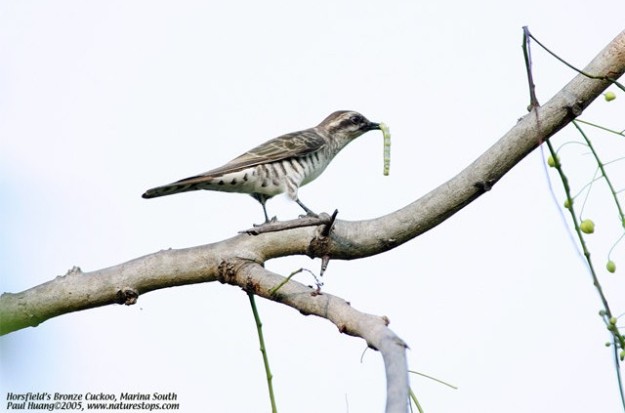
Figure #2 Adult Horsfield’s Bronze-cuckoo Chrysococcyx basalis feeding on a caterpillar of Catopsilia pomona at Marina City Park in May 2005 (© Paul Huang). The bold eyestripe, decurved eyebrow, whitish fringes to flight feathers and rufous on its outermost tail feather show well in this photo.
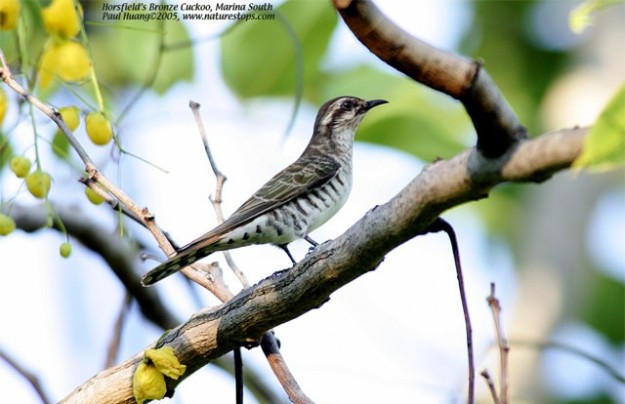
Figure #3 Adult Horsfield’s Bronze Cuckoo Chrysococcyx basalis at Marina City Park, May 2005 (© Paul Huang). Note the dark forehead, prominent decurved eyestripe and whitish fringes on wings.
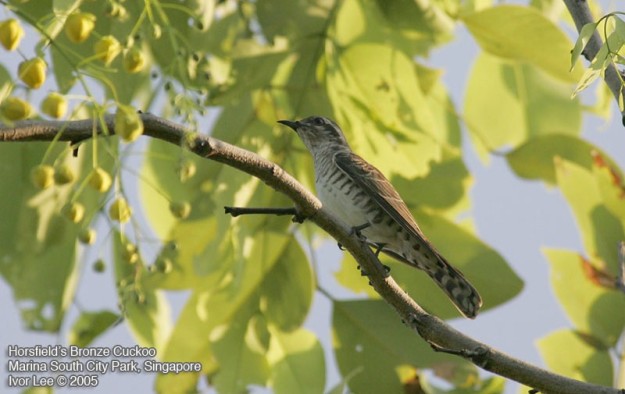
Figure #4 Adult Horsfield’s Bronze Cuckoo Chrysococcyx basalis at Marina City Park, May 2005 (© Ivor Lee). Note the streaked throat, broken bars from sides to under tail coverts and pale fringes to flight feathers.
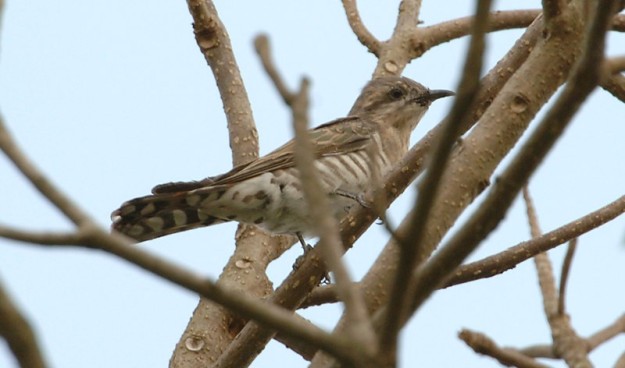
Figure #5A Immature Horsfield’s Bronze Cuckoo Chrysococcyx basalis at Choa Chu Kang Cemetery, July 2005 (© Con Foley). Note the dark eyestripe and brown wash on throat and upper breast.
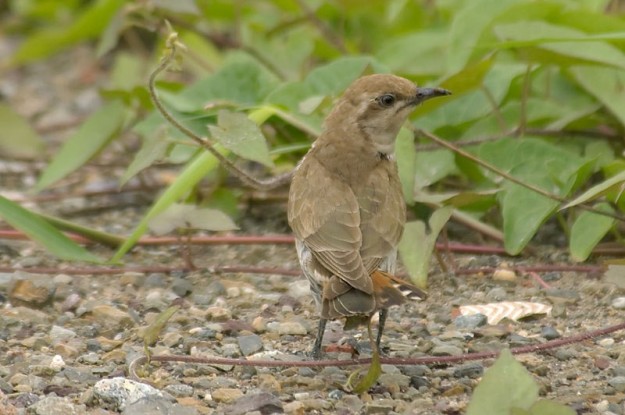
Figure #5B Immature Horsfield’s Bronze Cuckoo Chrysococcyx basalis on the ground at Marina East, June 2008 (© Mike Hooper). Note its distinct eyestripe, pale area behind eye, indistinct whitish fringes to wings, plain brown upperparts and rufous on bases of the two outermost tail feathers.
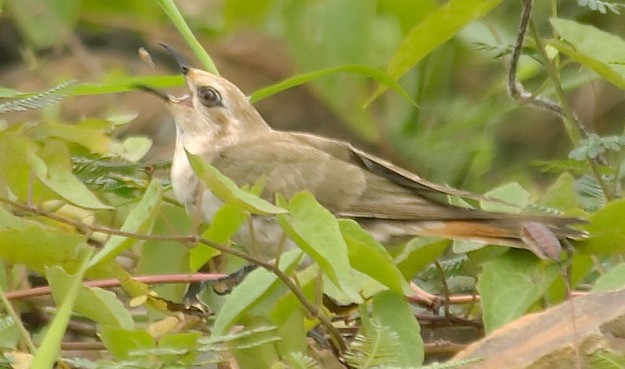
Figure #6 Immature Horsfield’s Bronze Cuckoo Chrysococcyx basalis feeding on unidentified prey at Marina East, June 2008 (© Mike Hooper). Note the clear eyestripe and eyebrow, dark eyering and rufous on outer tail.
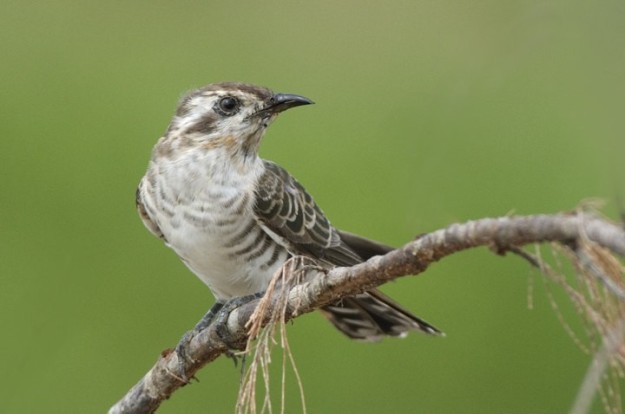
Figure #7 Immature Horsfield’s Bronze Cuckoo Chrysococcyx basalis at an unnamed spot in north-eastern Singapore, June 2008 (© Frankie Cheong). Note the rather blackish toned upperparts, dark forehead, broad whitish fringes to wings, and dark-streaked throat.
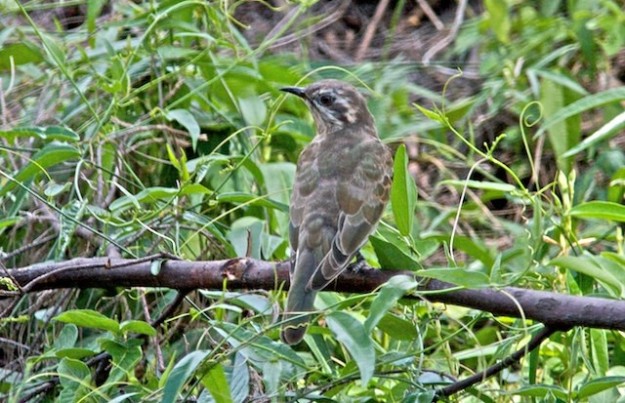
Figure #8 Adult Horsfield’s Bronze Cuckoo Chrysococcyx basalis at Changi Beach Park, July 2008 (© Lim Kim Chuah). Note the rather blotched bronze and green upperparts.
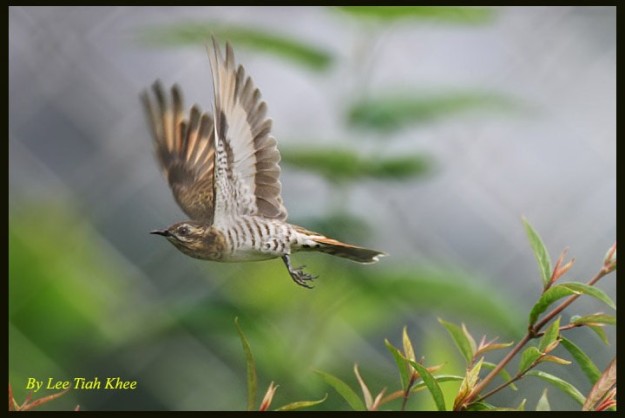
Figure #9 Adult Horsfield’s Bronze Cuckoo Chrysococcyx basalis at Kranji Coast, July 2008 (© Lee Tiah Khee). Note the clear eyestripe and eyebrow, black barred white wing coverts and broad white band at base of flight feathers.
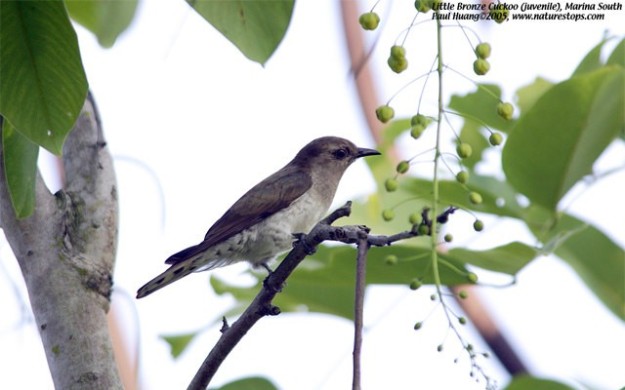
Figure #10 Immature Little Bronze Cuckoo Chrysococcyx minutillus at Marina City Park, May 2005 (© Paul Huang). Note the lack of eyestripe and underparts barring, and the lack of pale fringes to flight feathers.

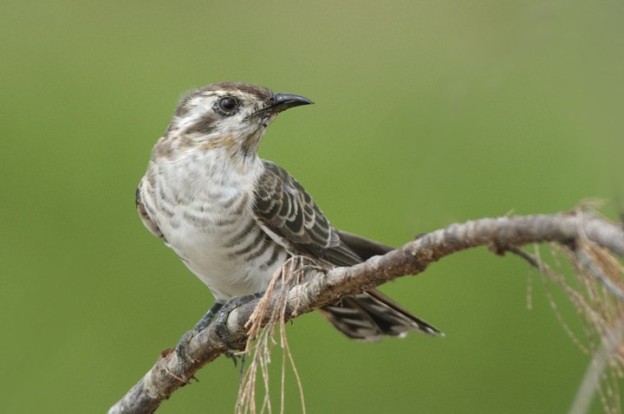
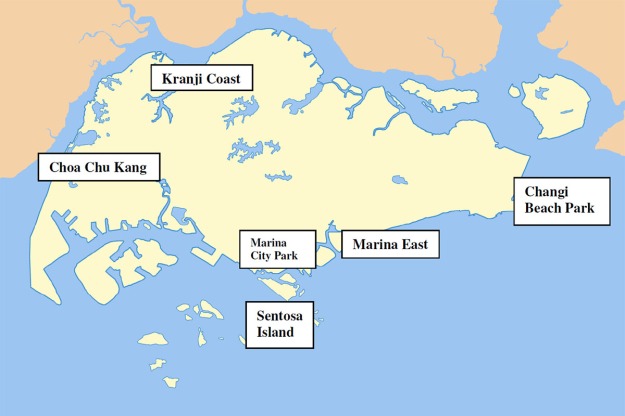
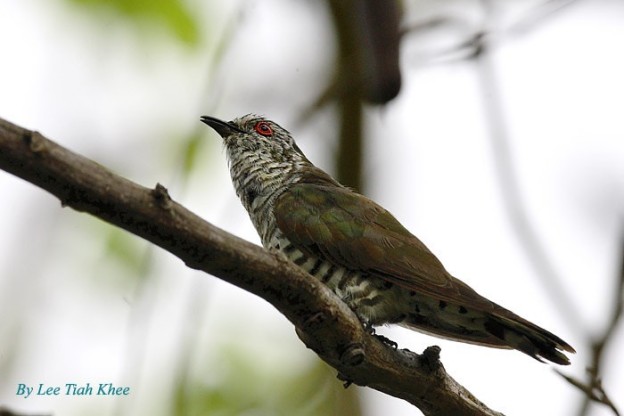
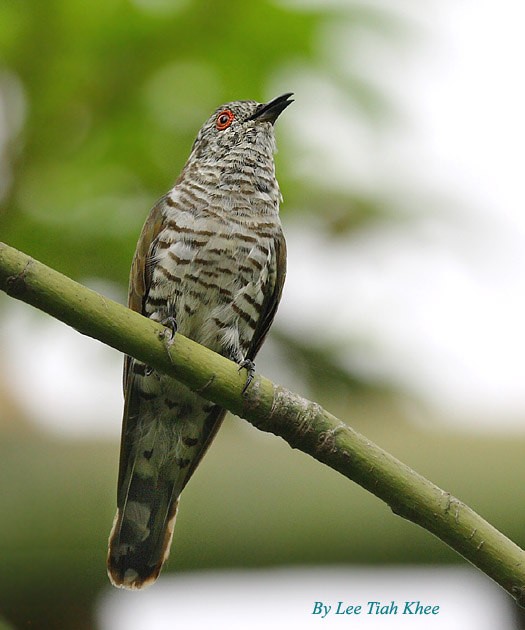
Saya baru dapat burung bronze cuckoc… Tadi nya saya bingung ini burung apa… Setelah baca artikel ini saya tahu ini burung bronze cuckoc.
Jadi dia makan ulat ya… 😊
LikeLike